By Bill Adams
Often, it’s the brightest, biggest, and newest innovations that catch the attention of trade show attendees. Seldom mentioned and often unnoticed are the small things on apparatus that should perk some interest. They’re features that purchasers may not have considered but perhaps should have. They also could be ones that purchasers might want to avoid when writing purchasing specifications. Some can “make or break” a rig’s performance.
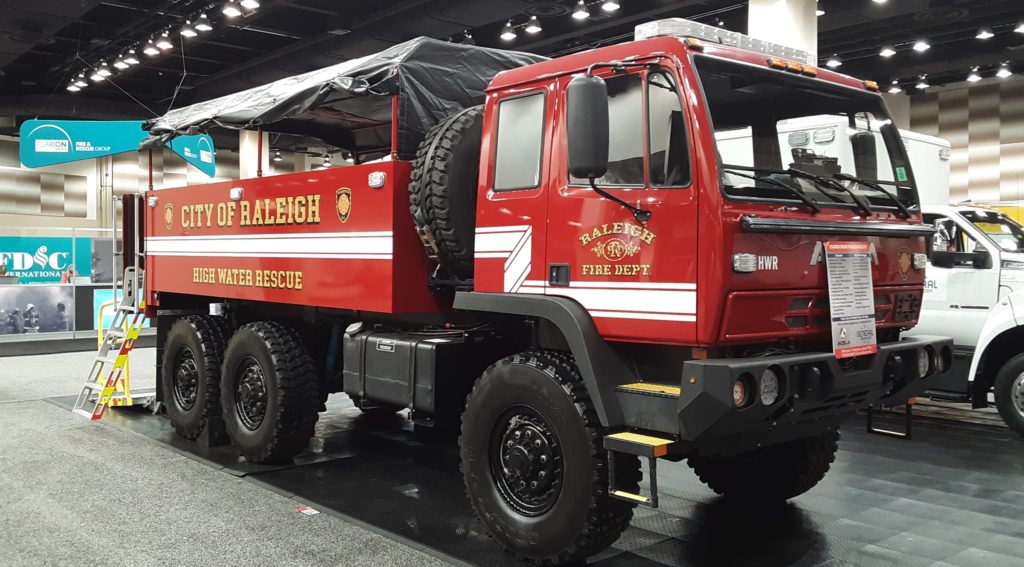
General Truck Body Manufacturing Company displayed a “High Water Rescue” unit on an Acela chassis—appropriate for the beginning of the late summer hurricane season.
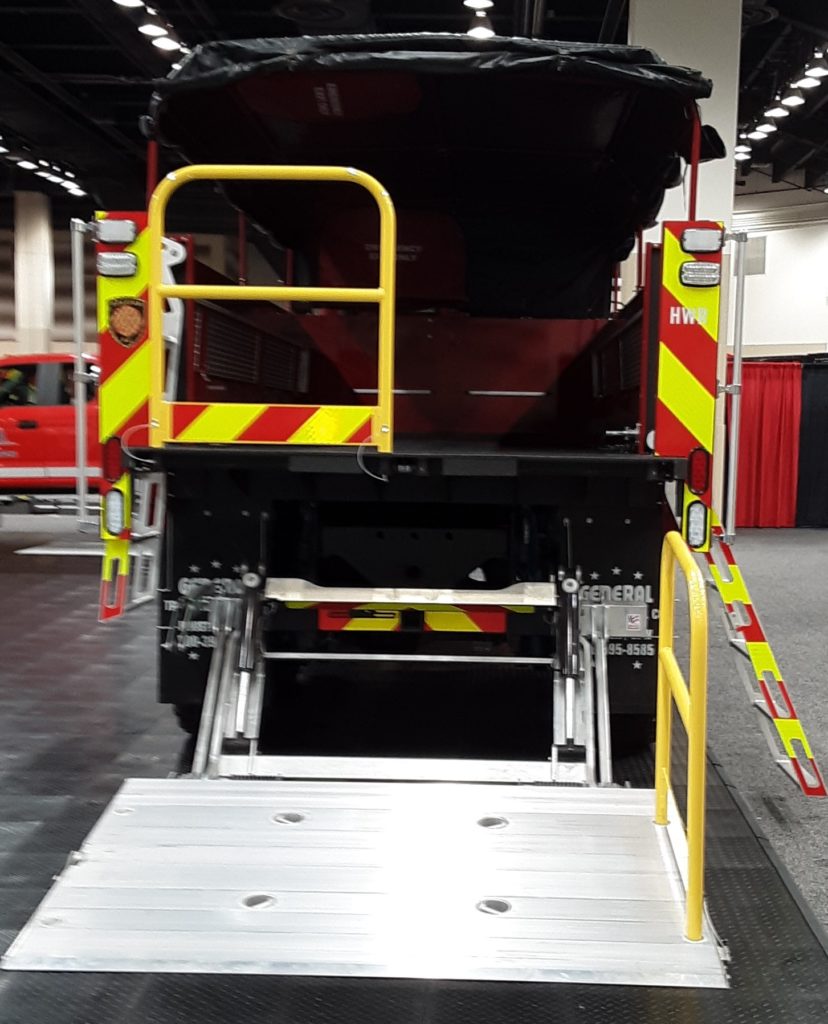
A first glance of the hydraulic tailgate at the rear and side access ladders made me wish the US Army 6×6’s in the late 1960s had them! A more practical observation is the gate enhances safe access and egress for firefighters and civilians rescued. Additionally, it allows for quick and easy loading of portable pumps and tools to fight fires when necessary in similar weather and terrain conditions.

This tanker by Midwest sports a busy back end with dump chutes on each side and one at the rear, plus two rear-gated tank fills—mounted low where they can be reached from ground level. I was trying to figure out the purpose for the two narrow treadplate boxes with slanted cuts on the outer corners. Midwest’s president and CEO Sarah Atchison said they are to accommodate up to 3-inch hose for the tank fills and the hose could be stored rolled, donut rolled, or packed flat and even preconnected. She said they can be made for any size or length hose. Not a bad idea.
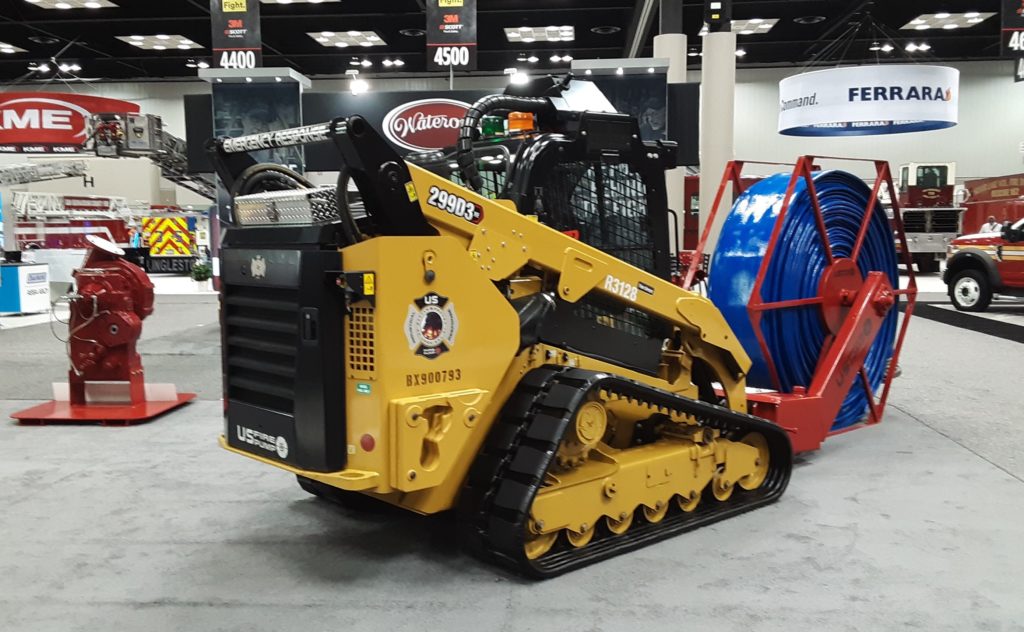
US Fire Pump, founded by Chris Ferrara, who also founded Ferrara Fire Apparatus, displayed a tracked Hose Recovery Vehicle than can handle 6- to 12-inch-diameter hose. If there was a Q and Roto-Ray on it, it would be fun to drive it down Main Street. The “thousands of GPM” high-capacity pump to the left of the rig is definitely not sized for a mini-pumper.
Gulf Highway Equipment displayed a rig I describe as a “crash attenuating vehicle.” The concept is an excellent use of an apparatus that might otherwise be disposed of. The large “directional sign board” on its top helps keep firefighters safe while working on a highway. I am not being a naysayer but want to express my opinion while it is admirable for the fire service to protect its own—I believe their safety on the highway is the responsibility of the police, sheriffs, state troopers, highway patrol or whatever you want to call law enforcement. Is the fire department responsible or liable if a motorist “obeying” the directional indicator on a fire truck gets into an accident while complying?
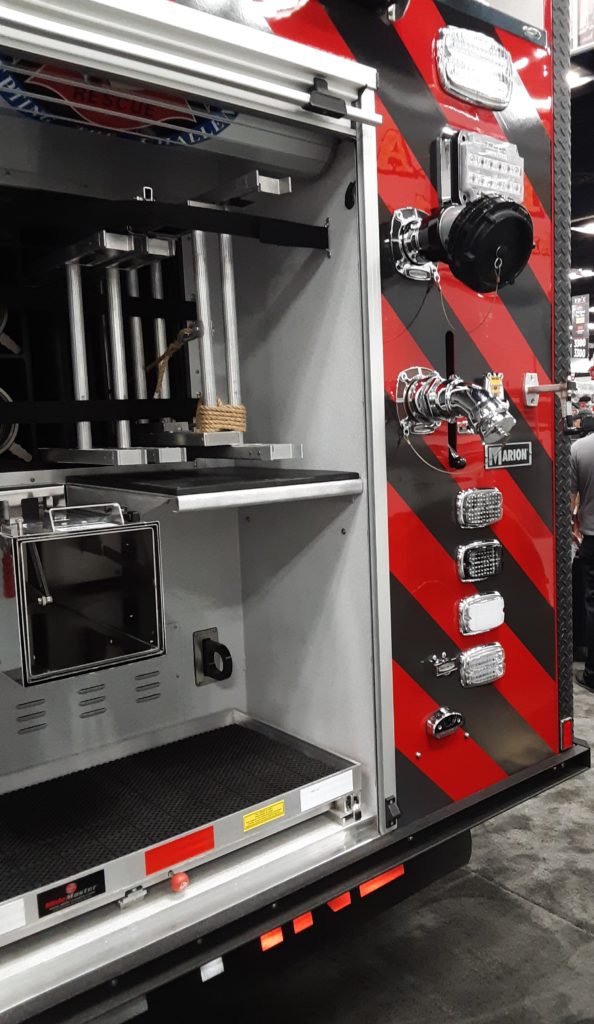
I originally took this picture of a Marion pumper-tanker to show some rear LDH discharges are located kind of high off the ground. Looking closely, there are some valuable trade-offs for its location. Protected in a “higher than normal” rear step compartment is a tank dump valve with an extendable chute. Also accessible low in the compartment are an extension ladder and two roof ladders along with some hard suctions. No doubt the slide-out tray at the bottom will be for heavy or often used equipment. On the exterior below the LDH connection is a gated direct tank fill reachable from ground level. It appears the most used and heaviest equipment is located where its easily accessible—a smart move. Specify exact locations if they are important.

At this year’s FDIC, several apparatus manufacturers displayed rigs with manually operated pump controls; one of them was Toyne. At several past shows, Toyne’s PRV (Priority Response Vehicle) featured a “slide-out and tilt-down” pump panel with all electronically operated valves. This year’s PRV had push-pull controllers in a stationary compact pump panel adjacent to the pump house. I didn’t want to speculate so I asked Toyne’s National Sales Manager Mike Watts: “How Come?”
He replied, “In 2014, Toyne designed the all-electric-controlled PRV which gives the department flexibility in locating the operator’s panel on the apparatus. It also gave the ability of having two panels on the apparatus, one on each side, allowing the driver/engineer to stage the apparatus for the safest operation at the scene. There are still some customers that are not comfortable with everything being electric, so we designed a hybrid panel of electric and manual controls that’s located in the driver’s side front compartment. The goal was to keep the most usable space in the front compartment as well as allowing the panel to be easily accessible for maintenance. The end product has accomplished that goal.”

This photo of Toyne’s PRV shows the curb side pump house. On similar designs by many manufacturers, it is unknown why there’s usually a 2½-inch speedlay above two 1¾-inch lays. On this particular rig, there’s also slide-in storage for back boards as well as a stokes basket and no 2½-inch preconnect (it’s probably in the rear). It could be this rig will run more calls where backboards and a stokes basket are used more often than a preconnected deuce-and-a-half.

This Rosenbauer pumper features the SAM all-electrically-controlled operator’s panel. The panel looks empty, but I’m sure the troops will find stuff to carry or mount there. It sports a 2½-inch speedlay and backboard storage above the usual two 1¾-inch preconnects. Vice President Brian Franz of Sentinel Emergency, the Rosenbauer dealer of record said, “It looks similar on the officer’s side, but the screen is bigger!”

Getting back to manual controls, especially on discharge valves—look at the pump panel on an FDNY Seagrave that was at the 2021 show. It sports a dozen manually operated crank handles. Let’s see, almost 200 active engine companies with a dozen manual controls each. These rigs catch a lot of workers. Maybe they’re on to something. But, remember, there are instances when design constraints mandate other-than-manual valve controls.

There are three interesting features on this Spartan that caught my eye. It has a single 1¾-inch speed lay and a 2½-inch speed lay on the bottom tier with the second 1¾-inch lay above them. If their procedure is the back-up line is one size bigger than the initial attack line then it makes sense to have them both lower where they are easier to reload. The other feature is a “dead lay” of hose next to the top preconnect. Seldom is spare hose carried near crosslays and speedlays. It is unknown why the dead load is only accessible from the pump operator’s side. Note the flop-down (aka swing-down!) step on the partial running board.
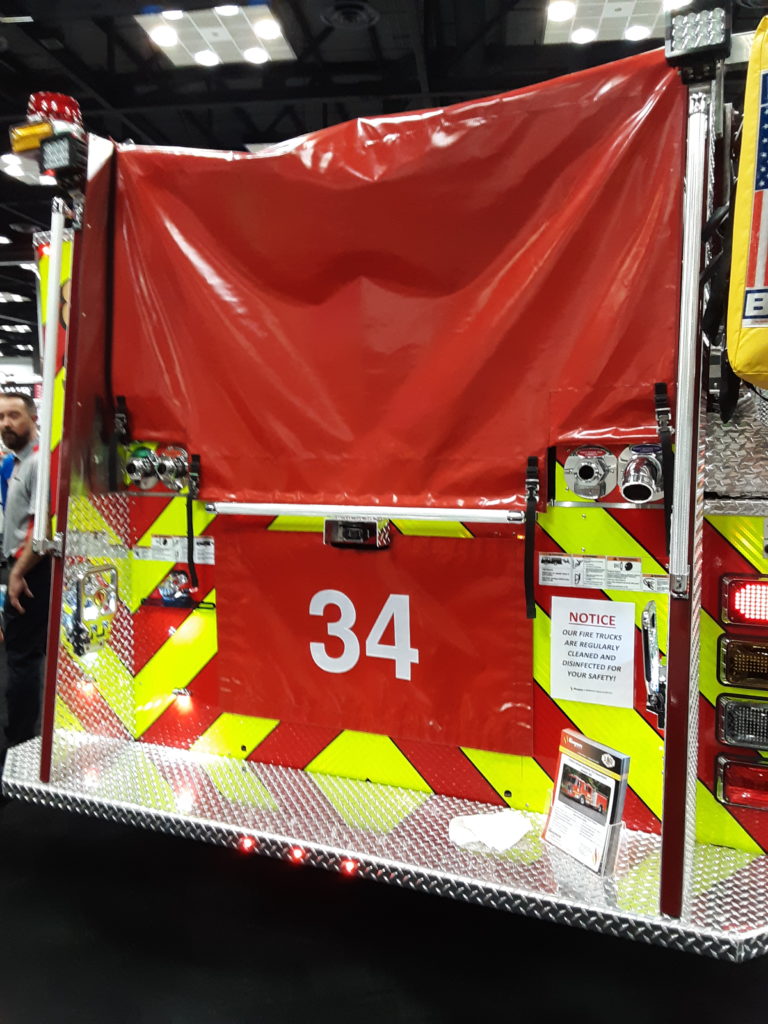
The working end of this Seagrave pumper sports four rear discharges, two on each side. The rear is the best place to locate hose connections—underneath the hose beds. The rear step compartment has a Velcro-attached cover in lieu of a roll-up or hinged door(s).
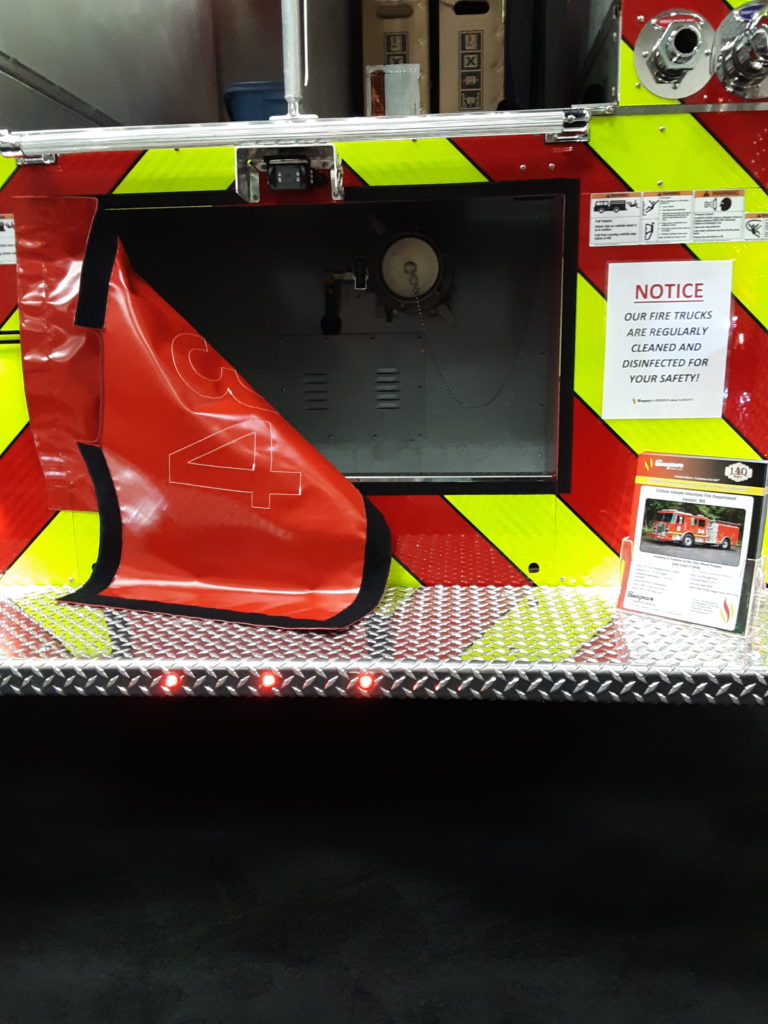
Tucked in an upper corner of the rear compartment is an LDH hose connection. It probably will have a preconnected pony length before it goes into service. The connection itself takes up about 8 inches by 8 inches. Why not stick it in a compartment? The upper portions of most compartments are seldom used.
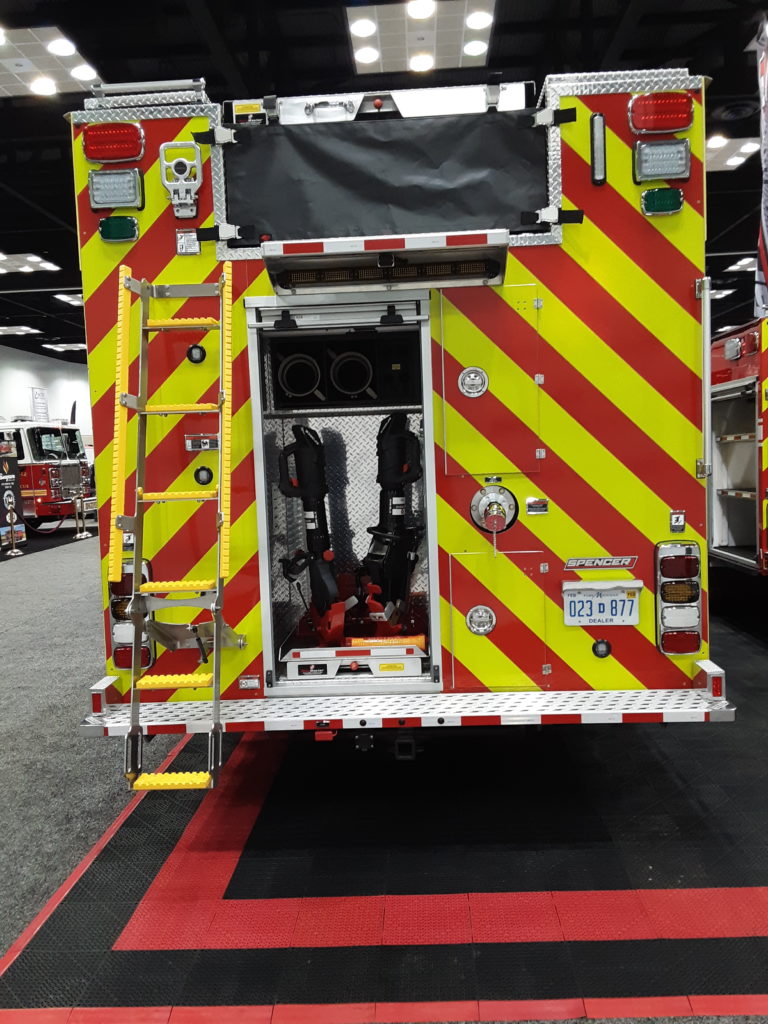
NEWSFLASH! There is no rule, regulation, or law stating that a rear step compartment has to be centered between the frame rails on a fire truck. This Spencer pumper has a rear center compartment off-set to the driver’s side. Most rigs’ frame rails are bobbed (cut off) to allow the floor of the rear step compartment to be the same level as the rear side compartments. It is possible to have one or both the side compartments behind the rear wheels deeper than “normal”—normal being frame rail depth. The deeper they are, the less width is the rear step compartment.



